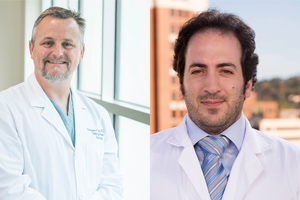 Christopher A. Girkin, M.D., MSPH, EyeSight Foundation of Alabama Chair, and Massimo A. Fazio, Ph.D., Assistant Professor in the University of Alabama at Birmingham Department of Ophthalmology and Visual Sciences have received a 4-year, $1,846,550 grant from the National Eye Institute (R01, Multi-PI) to explore the biomechanical behavior of the lamina cribrosa in the living human eye that is critical to the pathogenesis of glaucoma, pappiledema (swelling of the nerve due to increase intracranial pressure) and the visual impairment and intracrainla pressure syndrome experienced by some of our astronauts.
Christopher A. Girkin, M.D., MSPH, EyeSight Foundation of Alabama Chair, and Massimo A. Fazio, Ph.D., Assistant Professor in the University of Alabama at Birmingham Department of Ophthalmology and Visual Sciences have received a 4-year, $1,846,550 grant from the National Eye Institute (R01, Multi-PI) to explore the biomechanical behavior of the lamina cribrosa in the living human eye that is critical to the pathogenesis of glaucoma, pappiledema (swelling of the nerve due to increase intracranial pressure) and the visual impairment and intracrainla pressure syndrome experienced by some of our astronauts.
Primary open angle glaucoma is a leading cause of blindness in the developed world and biomechanics (tissue response to changes in pressure) of the optic nerve head thought to play an important role in the development of the disease. The axons from the retinal ganglion cells pass through the optic nerve head as they exit the eye through the sclera via the lamina cribrosa, a complex reticular connective tissue structure evolved to protects these axons as they pass from a region of higher presure within the eye to a region with lower pressure found in the brain. It is at this point that these axons are injured in the development of glaucoma. This new study provide a unique opportunity to directly examine the response of these tisuses to changes in both intraocular pressure but also intracranial pression (Figure) for the first time in the leving human eye.
The unique study was started by Drs. Girkin and Fazio in collaboration with the Alabama Eye Bank and the Alabama Organ Center and employs novel methods to evaluate the effects of changes in pressure both in the eye and in the brain for the first time in a living human eye. Dr Fazio has developed unique analytical and experimental methods to compute strain in the living eye and within the sclera (eye wall) that will be employed with this study. He was awarded the Wolfram Award for biomedical research in 2017 for his initial work in developing the computational methods for this study.
By defining the determinants of the biomechcanical response within these cirtical tissues the investigators strtive to design better biomarkers to detect and monitor glaucoma and develop new treatemnts aimed at surgically altering the posterior scleral to increase the resilience of these tissues to pressure related stress. These new thearapuetic modalities aimed at altering optic nerve biomechanics hold promise to prevent the development and progression of glaucoma and ultimately reduce the burden of blindness from from this tragic disease.
Left: Girkin/ Right: Fazio